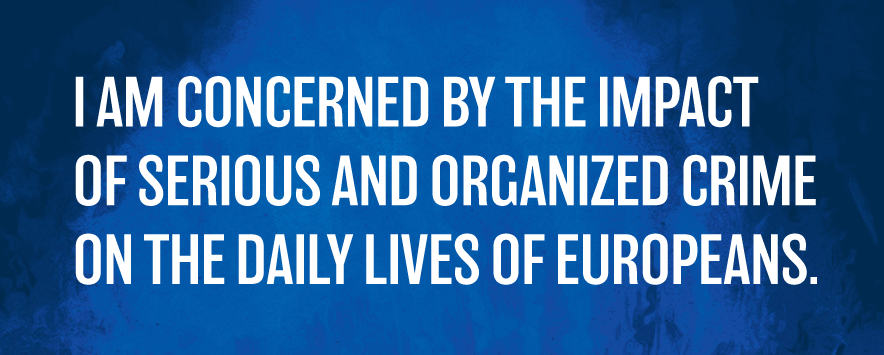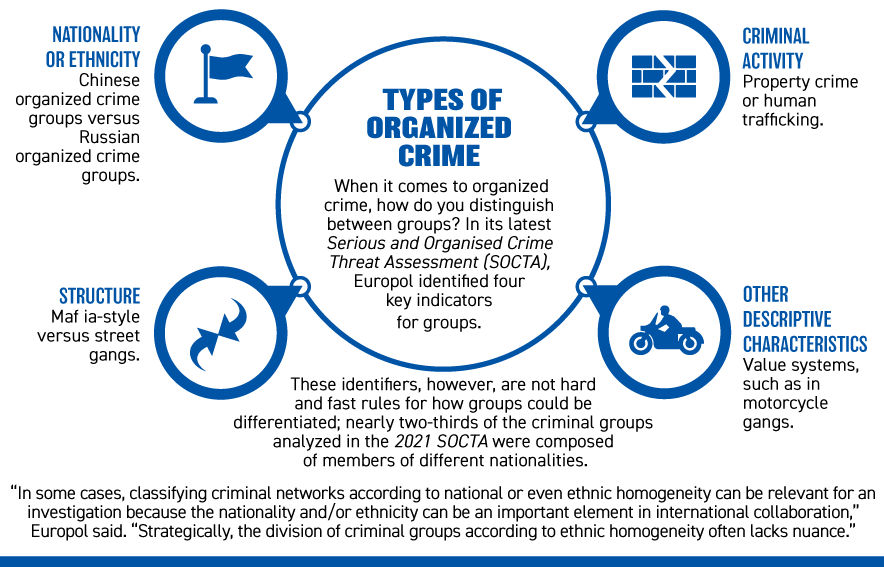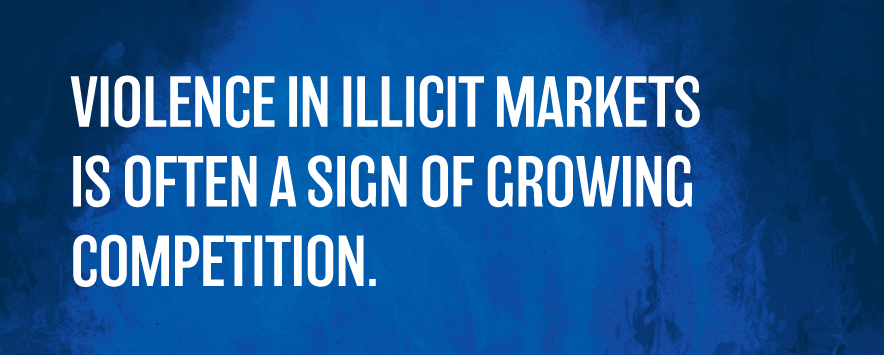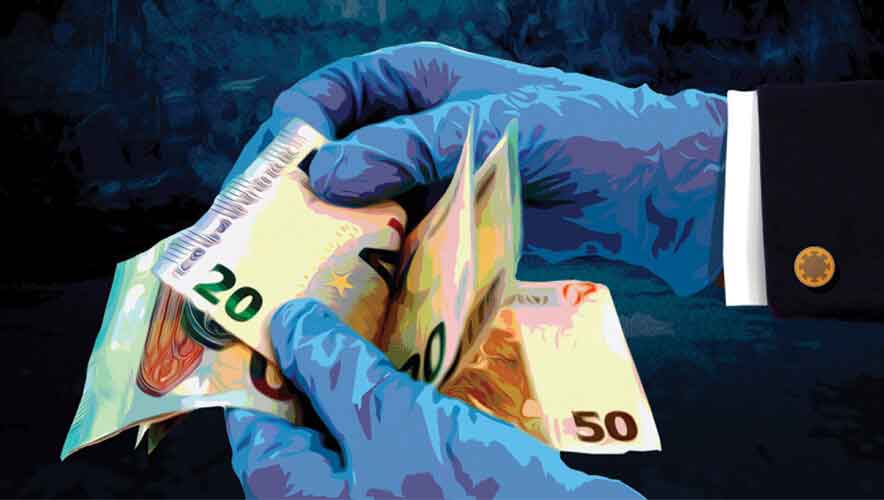A Pandemic Pivot: Organized Crime Finds a Way to Thrive in the New Abnormal
It started the way an investigation into an organized crime group often does. Investigators identified a group of Colombian, Dominican, and Spanish nationals who were part of a large-scale cocaine, hashish, and marijuana trafficking operation out of Cataluña, Spain. The authorities seized several shipments of cocaine in Colombia that were linked to the group—approximately 2,900 kilos worth..
But then, things took a turn. In February 2021, authorities arrested four individuals connected with the group in Tarragona, Spain, and seized 583 kilos of hashish that was intended for France and Italy. During the subsequent search of a warehouse used by the group, the authorities found half a submarine.
“The boat—the first ever of its kind seized on European soil, was still in construction when it was found,” according to Europol. “The craft was 9 meters long and could have been able to transport up to 2 tonnes of drugs.”
More than 300 police officers were involved in the operation, with support from the National Police of Colombia, the Dutch National Police, the Portuguese Judicial Police, the UK National Crime Agency, and the U.S. Customs and Border Protection Agency, with additional coordination aided by Europol.
The submarine, which the criminals presumably built to enhance their drug transportation capability, shows the lengths organized crime groups will go to in 2021 to evade detection and extend their reach during the COVID-19 pandemic—a time of economic turmoil with an element of global chaos.
In its most recent Serious and Organised Crime Threat Assessment (SOCTA), published in April 2021, Europol found that nearly 40 percent of the criminal networks active in the European Union are involved in the trade of illegal drugs, roughly 60 percent of these networks use violence as part of their criminal businesses, and that more than 80 percent of the criminal networks use legal business structures to facilitate their operations.
“The analysis indicates that criminal structures are more fluid and flexible than previously thought, use of violence by organized crime appears to be increasing, and use of corruption and abuse of legal business structures are key features of serious and organized crime activities,” wrote Europol Executive Director Catherine De Bolle in the report.
Europol’s analysis found that organized crime in 2021 is more flexible and changing in nature, “connecting individual criminal entrepreneurs and smaller groups of criminals mediated by information and contract brokers and supported by criminal service providers lending advice and assistance with expertise in law, finance, logistics, and many other specialist domains.”
The COVID-19 pandemic has also had a significant impact on the organized crime threat landscape in Europe, reshaping how criminal networks operate and uncovering new opportunities for them to thrive on.
“I am concerned by the impact of serious and organized crime on the daily lives of Europeans, and growth of our economy, and the strength and resilience of our state institutions,” De Bolle explained. “I am also concerned by the potential of these phenomena to undermine the rule of law.”
 Europe
Europe
Terrorism and serious and organized crime continue to pose the “most pressing internal security challenge” to the European Union, according to the 2021 SOCTA. This criminal activity ranges from the illegal drug trade to migrant smuggling to human trafficking to economic and financial crime.
“The trade in cocaine, cannabis, synthetic drugs, and new psychoactive substances is a key threat to the EU due to the levels of violence associated, the multibillion-euro profits generated, and the substantial harm caused by it,” the SOCTA explained.
Of the groups behind these practices, one in four has been active for more than 10 years; 40 percent use a hierarchical structure, compared to 60 percent with a fluid crime structure; and 79 percent have six or more members. Europol’s analysis found that more than 180 nationalities are involved, with seven out of 10 groups active in more than three countries.
“More than 50 percent of all reported suspected organized criminals active in the EU are non-EU nationals,” the SOCTA said. “Half of these non-EU nationals originate from countries in the EU’s neighborhood, such as the Western Balkan region, eastern European countries, and North Africa.”
A concerning trend highlighted in the report is that the level and use of violence associated with organized crime increased in frequency and severity since 2017.
“Violence in illicit markets is often a sign of growing competition (e.g., over the control of lucrative distribution networks or a particular geographic territory),” according to the SOCTA. “Shifting power balances within or between competing organized crime groups, the impact of law enforcement efforts, or broader economic pressures can also generate violence.”
This violence is seen in the form of threats, intimidation, vandalism, assault, kidnapping, torture, mutilation, and murder. It also takes the form of internal violence—within the group itself—to settle conflicts or punish individuals for breaking the group’s rules.
One of the major economic pressures that organized crime faced in 2020 and into 2021 was the threat of economic decline or recession related to the COVID-19 pandemic. In some instances, organized crime was able to take advantage of the situation.
“Criminals were quick to adapt illegal products, modi operandi, and narratives in order to exploit the fear and anxieties of Europeans and to capitalize on the scarcity of some vital goods during the pandemic,” according to the SOCTA. “While some criminal activities will or have returned to their pre-pandemic state, others will be fundamentally changed by the COVID-19 pandemic.”
In an analysis for Corporate Compliance Insights, Stefano Siggia, senior consultant at Pideeco, explained that the pandemic allowed mafia groups—such as the Sicilian Cosa Nostra, the Neapolitan Camorra, the Apulian Sacra Corona Unita, and the Calabrian ‘Ndrangheta—to acquire bankrupted entities and use them for profit, especially in Italy where COVID-19 hit particularly hard.
During 2020, banks lent less money to small- and medium-sized businesses, and the government saw an increase in requests for food aid from charities. In response, mafia groups took to distributing food to families facing financial difficulties—possibly as a recruitment method for business deals—and mafia organizations acquired failing businesses to help them obtain short-term financing in exchange for laundering money.
This also tied into another major finding from the 2021 SOCTA, which found that criminal networks are increasingly using legitimate business structures to enable their activities, such as through money laundering to integrate illicit funds into the legal economy.
“The COVID-19 pandemic may be followed by an economic recession,” the report said. “It is likely that criminals will exploit vulnerabilities in the economy to infiltrate legal businesses in order to facilitate their criminal activities. This may entail loaning funds to struggling businesses and making them dependent on criminal financiers or directly buying up companies in financial difficulties.”
 Southeast Asia
Southeast Asia
Halfway around the world in Indonesia, the COVID-19 pandemic is also having a major impact on organized crime. In normal times, millions of tourists flock to the country—and its famous island of Bali—but with the pandemic and subsequent travel restrictions, tourism spending was drastically down in the nation.
That’s when Adam Darrah, director of intelligence at Vigilante, and his team began noticing some odd online behavior. Due possibly to economic desperation, more individuals in Indonesia were turning to the Dark Web to buy access to stolen credentials, including those for bank accounts and streaming services like Netflix.
Before COVID-19, most cybercrime activity out of Indonesia centered around cyber activism in the form of website defacements, Darrah says. “They didn’t have a high reputation in the cyber criminal underground like the Chinese or the Russians,” he adds.
After COVID-19, more entry-level actors started engaging online with higher profile actors, asking for help to buy tools to use for cybercrime.
“We’re seeing an influx of requests for help: Where do we go to buy stuff? How do we buy stuff? Or do you know anyone who can help us increase our followers, say on Alibaba?” Darrah explains.
While some of these requests for help are happening on the Dark Web, some of them are being facilitated through one of the more obvious channels: Facebook. Darrah says Vigilante has seen an uptick in advertisements from criminal groups on Facebook, using the site’s advertising features to reach an audience that is then directed to testimonials and group chats on WhatsApp—also owned by Facebook.

In 2019, Facebook announced it removed hundreds of Indonesian accounts, pages, and groups, after discovering they were linked to an online group engaged in spreading fake news and hate speech.
“These accounts and pages were actively working to conceal what they were doing and were linked to the Saracen Group, an online syndicate in Indonesia,” said Nathaniel Gleicher, Facebook head of cybersecurity policy, in a statement.
However, as of Security Management’s press deadline Facebook had not taken action on the activity identified by Vigilante. And the ability for these criminals to learn, network, and market services on social media and online highlights another cause of concern for investigators looking to tackle organized crime—their increasing ability to use the Internet for gain.
“Social media mirror advertisements on websites and serve as dedicated channels for marketing or communication channels for criminal networks,” the SOCTA found. “All available illicit goods and services are also visible on social media.”
Europol also noted that organized criminals may use disinformation campaigns to generate sales for their products or lure individuals into fraud schemes. In addition, the law enforcement organization warned about a rise in the trend Vigilante had noticed in Indonesia—cybercrime-as-a-service.
“Criminal tools such as malware, ransomware, phishing facilitators, sniffers, skimmers, and distributed denial-of-service attacks are offered online, especially on the Dark Web,” the SOCTA said. “The crime-as-a-service business model makes criminal services easily available to anyone, lowering the level of expertise previously required to perform specific criminal activities.”
 Africa
Africa
Just as the world has become increasingly digital and mobile, so too has currency and banking. Nowhere else is that more apparent in the world than in Africa, which is considered the world leader in the mobile money industry with more than half of all registered mobile money accounts globally, according to Interpol.
Mobile money is generally a service that people can use to store, send, and receive money by using a mobile phone instead of a traditional brick-and-mortar bank. Users can also withdraw cash from authorized agents associated with their mobile money provider.
The ability to pay using only a mobile phone has aided the growth of Africa’s economy, but it also provided opportunities for organized crime groups to take advantage of the service.
In a 2020 assessment, Interpol found that the “lack of robust identity checks to verify users combined with a need for greater law enforcement resources and training on mobile money-enabled crimes have created a financial system distinctly vulnerable to criminal infiltration.”
Interpol said there were “strong indications” that mobile money is enabling criminality and poses a “significant threat” to African society through its use for terrorism financing, money laundering, extortion payments, human trafficking, people smuggling, and the illegal wildlife trade.
“In addition to this, mobile money service exploitation by criminals benefits from poorly applied regulations and expertise in the criminal justice system,” Interpol explained. “If this is not addressed, there is a significant risk of further criminal proliferation due to perceived risks versus rewards.”
This is especially concerning because the Global System for Mobile Communications Association (GSMA), which represents the interests of more than 750 mobile operators and 400 companies, said the mobile money market grew exponentially during the COVID-19 pandemic in response to lockdown restrictions.
GSMA’s annual State of the Industry Report on Mobile Money, published March 2021, noted that the “number of registered [mobile money] accounts grew by 13 percent globally in 2020 to more than 1.2 billion—double the forecast,” with the fastest growth happening in markets where governments provided relief to their citizens.
Additionally, in response to COVID-19 restrictions, some governments made regulatory changes to better facilitate mobile money payments, such as classifying them as essential services and increasing transaction limits to allow more funds to be transferred at one time.
Along with using mobile money markets, organized crime groups in Eastern Africa are taking advantage of the COVID-19 pandemic to move into the illicit medications market.
“A COVID-19 related hysteria has maximized profits for organized crime in this field, whilst enabling relatively risk-free activity for criminals,” according to an Interpol assessment. “This activity has included increased importations of counterfeit and substandard medications from Asia, as well as the acquisition of powerful painkillers to sell on the black market.”
In an analysis published in December 2020, Interpol said that organized crime groups are “capitalizing” on the increased demand for medication during the pandemic, importing illicit medications through the Mombasa port because of reduced capacity to inspect incoming shipments. Misinformation is also playing a role as it spreads across social media; Interpol explained that misinformation about COVID-19 has likely “increased the general willingness to source medications via illicit means.”
 Latin America
Latin America
In Latin America, the COVID-19 pandemic is impacting organized crime and the illegal drug market—especially supply, production, and trafficking chains—as many nations imposed border restrictions to limit the spread of the disease.
In a Wilson Center analysis published in October 2020, experts found that restrictions imposed by the United States—the final destination for most of Mexico’s methamphetamines, heroin, and cocaine—made it increasingly difficult for cartels to move drugs across the border. At the same time, Asian governments limited the transportation of merchandise—cutting down on the chemicals sent to Mexico used in the production of these drugs. China only recently eased some of its restrictions, allowing more shipments to Mexico.
“Thus, while the northern border still faces restrictions and interdiction measures, the local capacity for producing and manufacturing different types of illegal drugs has gradually recovered,” according to the Wilson Center report, Social Programs and Organized Crime in Mexico. “This situation clearly gives Mexican cartels an unprecedented and extremely delicate and risky alternative for Mexico’s national and public safety: growing, broadening, deepening, and developing the Mexican market for illegal drugs.”
To adapt to the situation, the cartels are ramping up their local capabilities and strategies for the drug market. They are also considering new avenues of funding, including providing basic goods to vulnerable populations where the government response to the pandemic has been “weak, scarce, or altogether nonexistent,” the report said.
The Mexican federal government also shifted its approach to organized crime, focusing more on the social causes of crime and violence instead of openly fighting the cartels.
“Facing less government pressure, the most powerful Mexican cartels have reinforced their distinct process of centralization and domination of territory, criminal markets, supply chain links, transportation routes, crime groups, organizations, and structures,” according to the report.
Latin America also saw an increase in violence during the COVID-19 pandemic as organized crime groups fought over territory, wrote Robert Muggah, principal at SecDev group, for Foreign Policy.
“Brazil’s three-year decline in homicide has come to a screeching halt,” he wrote. “In São Paulo, home to one of Latin America’s most powerful drug trafficking organizations, murders were up 10 percent between March 2019 and March 2020. And in the northern state of Ceará, violent crimes (including homicide) spiked by 98 percent in just 10 days in March. Levels of reported domestic violence have also surged in most states, including by more than 50 percent in Rio de Janeiro alone.”
Muggah tracked similar levels of rising violence in El Salvador, finding that mafia, militia, and criminal groups were reinforcing their soft power in the regions where they operate.
“In addition to fueling rising violence, the pandemic could enhance the social, economic, and political clout of some criminal organizations in the same way that the Italian mafia and Japanese yakuza emerged stronger after the great dislocations of World War II,” he wrote. “Crime bosses know full well that law enforcement and criminal justice systems are overstretched and that prisons are bursting at the seams in Latin America and elsewhere. They also know great scarcity is coming, which may increase the risk of violence. The question is whether we are even remotely ready.”
Megan Gates is senior editor at Security Management. Connect with her at [email protected]. Follow her on Twitter: @mgngates.












